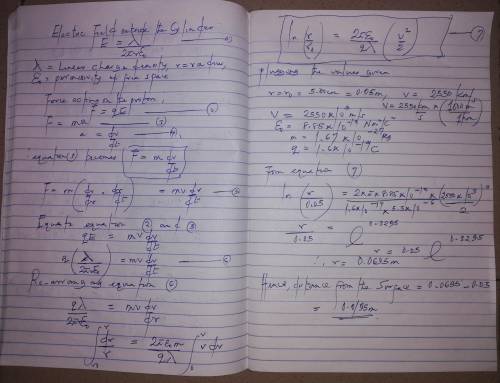
Physics, 14.02.2020 04:05 Tyrant4life
A very long nonconducting cylinder of diameter 10.0 cm carries charge distributed uniformly over its surface. Each meter of length carries +5.50 µC of charge. A proton is released from rest just outside the surface. How far will it be from the SURFACE of the cylinder when its speed has reached 2550 km/s? (k = 1/4πε0 = 8.99 × 10^9 N. m^2/C2, e = 1.60 × 10^-19 C, m proton = 1.67 x 10^-27 kg)

Answers: 1
Another question on Physics

Physics, 22.06.2019 11:30
In order of decreasing light-transmitting capabilities of materials, which is the correct sequence? a. transparent -> translucent -> opaque b. opaque -> transparent -> translucent c. opaque -> translucent -> transparent d. translucent -> transparent -> opaque
Answers: 1

Physics, 22.06.2019 12:40
Question part points submissions used suppose that 2 j of work is needed to stretch a spring from its natural length of 26 cm to a length of 36 cm. (a) how much work is needed to stretch the spring from 28 cm to 32 cm? (round your answer to two decimal places.)
Answers: 2

Physics, 22.06.2019 14:00
How to tell if two objects are in thermal equilibrium 1.the objects have the same temperature 2.the objects are the same size 3.the objects are touching each other 4.the objects temperatures are changing
Answers: 1

Physics, 22.06.2019 14:40
The experiment done in lab is repeated, using a ball that has unknown mass m. you plot your data in the form of f 2 versus m/l, with f in rev/s, m in kg, and l in m. your data falls close to a straight line that has slope 3.19 m/(kg · s2). use g = 9.80 m/s2 and calculate the mass m of the ball.
Answers: 1
You know the right answer?
A very long nonconducting cylinder of diameter 10.0 cm carries charge distributed uniformly over its...
Questions

Mathematics, 10.11.2020 02:20


SAT, 10.11.2020 02:20


Mathematics, 10.11.2020 02:20

Mathematics, 10.11.2020 02:20



Mathematics, 10.11.2020 02:20



Mathematics, 10.11.2020 02:20


Mathematics, 10.11.2020 02:20

Chemistry, 10.11.2020 02:20


English, 10.11.2020 02:20

Mathematics, 10.11.2020 02:20

Mathematics, 10.11.2020 02:20




